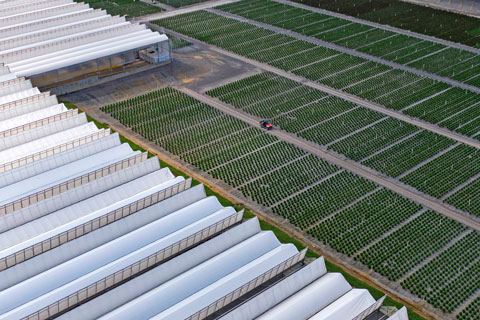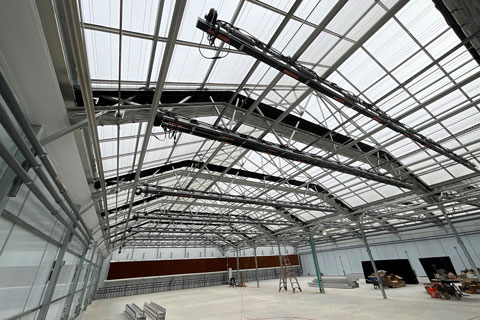4/1/2024
Locate, Deliberate, Integrate
Jennifer Zurko

When you’re in the market for a new home, there are a lot of things to consider. With the advent of apps like Zillow you can pretty much search for any criteria you want.
Pictured: Metrolina’s perennial production operation in York, South Carolina, was previously Stacy’s Greenhouses. After a long-time contract-growing partnership, Louis Stacy sold the property to the VanWingerden family in 2013, who’ve continued to upgrade and expand it.
Obviously, location is top priority, but once you drill down from there, you’ve really got to make some choices: Do I want to buy a fixer-upper because I’m handy and I have the resources to get a cheaper place and make the renovations myself? Does my house need to be move-in-ready because I don’t want to spend the time or money on doing anything beyond a new coat of paint? Or do I just start from scratch and build brand new?
The questions are similar when you’re looking to expand your greenhouse space, too. If you’ve never been faced with having to make this decision before, you may think it’s easier to just build a new one from the ground up. However, with some recent unfortunate circumstances having to do with a few well-known wholesalers and lots of cannabis growers going out of business, the opportunities to add on by not having to deal with contractors and construction may be pretty appealing.
Buying someone else’s already-existing greenhouse may not be palatable to every grower. It just depends on what your resources, your mindset and your goals are.
Moving in and making some changes
There are purists in this industry who want the land and facilities of any growing business closing up shop to stay “in the family,” so to speak—they hope that another grower will just buy the property and start growing their own stuff in it. You see it sometimes, but there’s some strategy that has to be involved to make those decisions, for both parties.
Chris Copeland is the COO for Metrolina Greenhouses’ facility in York, South Carolina, which used to be Stacy’s Greenhouses. Metrolina acquired Stacy’s in 2013 after a long-time relationship between Louis Stacy and the VanWingerden family, who owns Metrolina. When Louis was ready to sell, it seemed like a natural fit, and Chris said that was a significant advantage.
“They knew each other and the culture quite well,” he explained. “The team members of Stacy’s who are still here with us fundamentally understood that what Metrolina brought to the table was the high emphasis on technology, investment and aggressive growth. And they were all in for that challenge.”
Stacy’s was already contract growing perennials for Metrolina, so the VanWingerdens knew it was a good operation, but they also knew that they were going to have to make some changes to meet their goals. It was move-in ready, but they needed to put their own personal touches on it.
“Upon the announcement of the acquisition, Art and Abe [VanWingerden] had very specific objectives in mind,” said Chris. “They wanted to improve their distribution capabilities. Obviously, that is one of Metrolina’s strengths. Improve on production, which would mean centralization of all transplant activity.
“They always knew that Stacy’s was a very high-quality grower, so the product itself was very good. And the processes were in place to grow good-quality product. Metrolina brought to that a different look on efficiency, different ideas. And I think there was a mutual respect on the part of Metrolina for Stacy’s: ‘Hey, these guys know how to grow great perennial products—let’s just let them do it and give them the tools to do it better.’”
 Pictured: A cannabis greenhouse has stricter requirements, like smaller zones with more walls and more sophisticated curtain systems, which is why it’s harder to convert from a traditional bedding plant greenhouse.
Pictured: A cannabis greenhouse has stricter requirements, like smaller zones with more walls and more sophisticated curtain systems, which is why it’s harder to convert from a traditional bedding plant greenhouse.
Those tools include technology upgrades that have advanced and expanded over the years, such as Metrolina’s forecasting, demand planning, and sales and replenishment platforms, along with inventory management and supply chain management capabilities, and greenhouse automation systems.
“Yes, you should get savings at both companies when combining key departments like logistics, bulk buying and efficient staffing,” said Abe VanWingerden, Metrolina’s co-CEO. “Second, you can possibly gain customers or market share, which is what we did with the acquisition. Third, acquisitions should bring new ideas, new product lines, expanded capacity or new innovations.
“But, beyond the numbers, the biggest win possible is when you realize that both parties can learn from each other, especially the acquiring company. There were things that were done in York pre-acquisition that we have taken as best practices for our other facilities, so the learning and culture development works all ways, not just one way. That mentality that we can learn from everyone is what made the transition work best.”
Next, integrate
One of the first things Metrolina did when they acquired Stacy’s was to cover the loading space. Chris said that essentially it was 10 acres of concrete pad where staff had to load orders rain or shine. And it can get pretty hot out in the South Carolina sun during the summer, so they erected a greenhouse structure over the entire area. At the same time, they upgraded the trucking fleet and started recruiting new drivers and contractors.
To that end, it’s not just the physical structures and equipment you have to worry about when you acquire an existing business, but there’s also a human/personal element because of staffing. Whenever a company comes under new ownership, it’s a stressful time for the employees who already work there, and the new owners have to be cognizant of that.
“Any time you go through an acquisition, the people part of it and the culture changes that occur early on can be painful for both parties,” said Chris. “Often times, it’s the most difficult part of an acquisition. But we’re still very fortunate that quite a few original Stacy’s employees and some of their top-ranking directors and managers are still here today and contributing in a tremendous way.”
There was some attrition in the beginning and that was because Metrolina has strict hiring policies, which includes using E-verify to check that the people they hire are legally allowed to work in the United States. And because York is a small town with a limited supply of local labor, the business had been perennially challenged to hire the 300 employees per year needed for seasonal work. Ultimately, implementing an H-2A program has provided some significant efficiencies.
“Today, we do the same amount of work—actually a little bit more—with less than half the number of people that we used to hire,” Chris said.
More than 95% of the production at the York facility is for perennials, which has allowed Metrolina to offer a wider product offering to their big box customers.
“It’s been very good for our existing business and a prime example of that is we provide a very diverse offering of programs for certain retailers,” explained Chris. “So instead of the stores getting six deliveries a day, we’re consolidating different plant categories and they get one delivery a day. Had Metrolina tried to do that prior to the acquisition, they would have had to go out and buy those products from others and consolidate it all through [the] Huntersville [location]. So by acquiring an existing facility that was already in a major product category with additional loading space, it’s given us the ability to load product effectively without bottlenecking.”
During the last 11 years, Metrolina has slowly worked to upgrade the facility with new innovations and processes, while expanding the space. Chris said they’re currently expanding on the first 100-acre track that was acquired, netting them approximately 85 additional acres of outdoor production space. They’ve added cold frame space and a centralized potting structure. They’re also adding a 13-acre shade structure this year.
“We’re building constantly on this property,” Chris said with a chuckle. “We haven’t had a year yet when we weren’t building something.”
When It’s Better to Build New
If you’re not lucky enough to already know the previous owners or business, you’ll need to do some more groundwork, especially if you’re growing a completely different crop. And it’s much more difficult depending on that crop.
For instance, you don’t often see a cannabis grower moving into an old bedding plant greenhouse. This is the real fixer-upper scenario.
“Cannabis structures are just designed so much differently than anything else,” said Al Sray, who’s been in the greenhouse sector for over 16 years; the last few have been as a Senior Account Manager-Cannabis for Prospiant. “Significant security and structural upgrades, along with blackout upgrades, are usually needed for these greenhouses to convert them to cannabis, as well as a much more sophisticated water-treatment and fertigation system, and a much more sophisticated control system.”
Plus, power is a huge factor to consider if you’re growing cannabis. Al said you may not only need a lot of internal electrical work, but potentially additional service from your electric company to the site itself, which may entail adding a transformer that can take up to a year and cost over $1 million.
This is not to say that Al hasn’t seen instances of cannabis growers moving into an established annuals or perennials greenhouse, especially since it’s getting harder for these businesses to secure traditional financing. But you have to be prepared for what needs to be done and many have decided that building new is just a better option for what they need.
“At the end of the day, there’s not much cost savings realized when taking over an existing horticultural greenhouse and converting it to cannabis, just because of all of the upgrades that need to be done,” explained Al. “If you’re talking about a 30-year-old greenhouse, a lot of times you can’t even find blueprints for those. And they were built under old building codes that are no longer relevant.
“Ideally, anyone that’s looking to buy a greenhouse and convert it to cannabis should have an experienced greenhouse company come in before they make the purchase, so that a proper evaluation can be done as to what exactly is needed. Adding after the fact is very difficult. It’s probably double the cost of putting it in initially. If you’re building it new, you stage your construction process appropriately so it’s easier to do.”
What Al is seeing more of are finished produce growers taking over cannabis operations. Established cannabis greenhouses seem to be a better fit for these growers who need a controlled indoor environment all year round.
“You really want to have crops in there that you can turn for 12 months,” Al said. “Obviously, lettuce and produce, in most places, is a 12-month-out-of-the-year crop in most greenhouses. And we’re seeing more of that.” —JZ